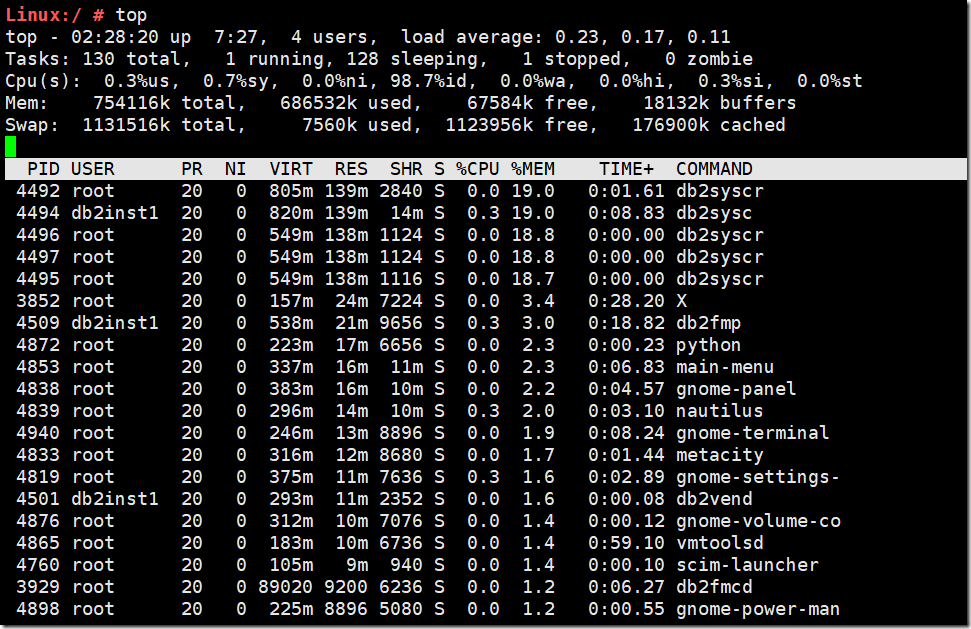1.w命令
w命令是一个很强大的命令,该命令显示的信息比较丰富。以下是我的虚拟机w命令的一个展示
从上图我们可以看到:
第一行从左面开始显示的信息依次为:时间、系统运行时间、登陆用户数、平均负载
第二行以及下面所有行告诉我们,当前登陆的用户以及从哪里登陆的
我们重点关注一下load average
第一个数值表示1分钟内系统的平均负载值;第二个数值表示5分钟系统的平均负载值;第三个数值表示的是系统15分钟内的平均负载值,这个值的意义是单位时间段内CPU进程活动数,这个值越大就说明服务器压力越大
一般情况下这个值只要不超过CPU数量就没关系,那么CPU数量如何查看呢?
2.查看CPU数量
Linux:/ # cat /proc/cpuinfo
processor : 0
vendor_id : GenuineIntel
cpu family : 6
model : 78
model name : Intel(R) Core(TM) i5-6200U CPU @ 2.30GHz
stepping : 3
microcode : 186
cpu MHz : 2400.000
cache size : 3072 KB
fpu : yes
fpu_exception : yes
cpuid level : 22
wp : yes
flags : fpu vme de pse tsc msr pae mce cx8 apic sep mtrr pge mca cmov pat pse36 clflush dts mmx fxsr sse sse2 ss syscall nx pdpe1gb rdtscp lm constant_tsc up arch_perfmon pebs bts nopl xtopology tsc_reliable nonstop_tsc aperfmperf pni pclmulqdq ssse3 fma cx16 pcid sse4_1 sse4_2 x2apic movbe popcnt xsave avx f16c rdrand hypervisor lahf_lm 3dnowprefetch ida arat epb pln pts dtherm fsgsbase smep
bogomips : 4800.00
clflush size : 64
cache_alignment : 64
address sizes : 40 bits physical, 48 bits virtual
power management:
Linux:/ # cat /proc/cpuinfo processor : 0 vendor_id : GenuineIntel cpu family : 6 model : 78 model name : Intel(R) Core(TM) i5-6200U CPU @ 2.30GHz stepping : 3 microcode : 186 cpu MHz : 2400.000 cache size : 3072 KB fpu : yes fpu_exception : yes cpuid level : 22 wp : yes flags : fpu vme de pse tsc msr pae mce cx8 apic sep mtrr pge mca cmov pat pse36 clflush dts mmx fxsr sse sse2 ss syscall nx pdpe1gb rdtscp lm constant_tsc up arch_perfmon pebs bts nopl xtopology tsc_reliable nonstop_tsc aperfmperf pni pclmulqdq ssse3 fma cx16 pcid sse4_1 sse4_2 x2apic movbe popcnt xsave avx f16c rdrand hypervisor lahf_lm 3dnowprefetch ida arat epb pln pts dtherm fsgsbase smep bogomips : 4800.00 clflush size : 64 cache_alignment : 64 address sizes : 40 bits physical, 48 bits virtual power management:
上述参数释意
processor :系统中逻辑处理核的编号。对于单核处理器,则课认为是其CPU编号,对于多核处理器则可以是物理核、或者使用超线程技术虚拟的逻辑核
vendor_id :CPU制造商
cpu family :CPU产品系列代号
model :CPU属于其系列中的哪一代的代号
model name:CPU属于的名字及其编号、标称主频
stepping :CPU属于制作更新版本
cpu MHz :CPU的实际使用主频
cache size :CPU二级缓存大小
physical id :单个CPU的标号(由于我的虚拟机只有一个CPU,所以无以下红色标记信息项)
siblings :单个CPU逻辑物理核数
core id :当前物理核在其所处CPU中的编号,这个编号不一定连续
cpu cores :该逻辑核所处CPU的物理核数
apicid :用来区分不同逻辑核的编号,系统中每个逻辑核的此编号必然不同,此编号不一定连续
fpu :是否具有浮点运算单元(Floating Point Unit)
fpu_exception :是否支持浮点计算异常
cpuid level :执行cpuid指令前,eax寄存器中的值,根据不同的值cpuid指令会返回不同的内容
wp :表明当前CPU是否在内核态支持对用户空间的写保护(Write Protection)
flags :当前CPU支持的功能
bogomips :在系统内核启动时粗略测算的CPU速度(Million Instructions Per Second)
clflush size :每次刷新缓存的大小单位
cache_alignment :缓存地址对齐单位
address sizes :可访问地址空间位数
power management :对能源管理的支持,有以下几个可选支持功能:
ts: temperature sensor

fid: frequency id control
vid: voltage id control
ttp: thermal trip
tm:
stc:
100mhzsteps:
hwpstate:
CPU信息中flags各项含义:
fpu: Onboard (x87) Floating Point Unit
vme: Virtual Mode Extension
de: Debugging Extensions
pse: Page Size Extensions
tsc: Time Stamp Counter: support for RDTSC and WRTSC instructions
msr: Model-Specific Registers
pae: Physical Address Extensions: ability to access 64GB of memory; only 4GB can be accessed at a time though
mce: Machine Check Architecture
cx8: CMPXCHG8 instruction
apic: Onboard Advanced Programmable Interrupt Controller
sep: Sysenter/Sysexit Instructions; SYSENTER is used for jumps to kernel memory during system calls, and SYSEXIT is used for jumps: back to the user code
mtrr: Memory Type Range Registers
pge: Page Global Enable
mca: Machine Check Architecture
cmov: CMOV instruction
pat: Page Attribute Table
pse36: 36-bit Page Size Extensions: allows to map 4 MB pages into the first 64GB RAM, used with PSE.
pn: Processor Serial-Number; only available on Pentium 3
clflush: CLFLUSH instruction
dtes: Debug Trace Store
acpi: ACPI via MSR
mmx: MultiMedia Extension
fxsr: FXSAVE and FXSTOR instructions
sse: Streaming SIMD Extensions. Single instruction multiple data. Lets you do a bunch of the same operation on different pieces of input: in a single clock tick.
sse2: Streaming SIMD Extensions-2. More of the same.
selfsnoop: CPU self snoop
acc: Automatic Clock Control
IA64: IA-64 processor Itanium.
ht: HyperThreading. Introduces an imaginary second processor that doesn’t do much but lets you run threads in the same process a bit quicker.
nx: No Execute bit. Prevents arbitrary code running via buffer overflows.
pni: Prescott New Instructions aka. SSE3
vmx: Intel Vanderpool hardware virtualization technology
svm: AMD “Pacifica” hardware virtualization technology
lm: “Long Mode,” which means the chip supports the AMD64 instruction set
tm: “Thermal Monitor” Thermal throttling with IDLE instructions. Usually hardware controlled in response to CPU temperature.
tm2: “Thermal Monitor 2″ Decrease speed by reducing multipler and vcore.
est: “Enhanced SpeedStep”
根据以上内容,我们则可以很方便的知道当前系统关于CPU、CPU的核数、CPU是否启用超线程等信息。
3.vmstat 监控系统的状态
输出字段释意
Procs
r: The number of processes waiting for run time.
等待运行的进程数。如果等待运行的进程数越多,意味着CPU非常繁忙。另外,如果该参数长期大于和等于逻辑cpu个数,则CPU资源可能存在较大的瓶颈。
b: The number of processes in uninterruptible sleep.
处在非中断睡眠状态的进程数。意味着进程被阻塞。主要是指被资源阻塞的进程对列数(比如IO资源、页面调度等),当这个值较大时,需要根据应用程序来进行分析,比如数据库产品,中间件应用等。
Memory
swpd: the amount of virtual memory used.
已使用的虚拟内存大小。如果虚拟内存使用较多,可能系统的物理内存比较吃紧,需要采取合适的方式来减少物理内存的使用。swapd不为0,并不意味物理内存吃紧,如果swapd没变化,si、so的值长期为0,这也是没有问题的
free: the amount of idle memory.
空闲的物理内存的大小
buff: the amount of memory used as buffers.
用来做buffer(缓存,主要用于块设备缓存)的内存数,单位:KB
cache: the amount of memory used as cache.
用来做cache(缓存,主要用于缓存文件)的内存,单位:KB
inact: the amount of inactive memory. (-a option)
inactive memory的总量
active: the amount of active memory. (-a option)
active memroy的总量。
Swap
si: Amount of memory swapped in from disk (/s).
从磁盘交换到内存的交换页数量,单位:KB/秒。
so: Amount of memory swapped to disk (/s).
从内存交换到磁盘的交换页数量,单位:KB/秒
内存够用的时候,这2个值都是0,如果这2个值长期大于0时,系统性能会受到影响,磁盘IO和CPU资源都会被消耗。
当看到空闲内存(free)很少的或接近于0时,就认为内存不够用了,这个是不正确的。不能光看这一点,还要结合si和so,
如果free很少,但是si和so也很少(大多时候是0),那么不用担心,系统性能这时不会受到影响的。
当内存的需求大于RAM的数量,服务器启动了虚拟内存机制,通过虚拟内存,可以将RAM段移到SWAP DISK的特殊磁盘段上,
这样会 出现虚拟内存的页导出和页导入现象,页导出并不能说明RAM瓶颈,虚拟内存系统经常会对内存段进行页导出,
但页导入操作就表明了服务器需要更多的内存了, 页导入需要从SWAP DISK上将内存段复制回RAM,导致服务器速度变慢。
IO
bi: Blocks received from a block device (blocks/s).
每秒从块设备接收到的块数,单位:块/秒 也就是读块设备。
bo: Blocks sent to a block device (blocks/s).
每秒发送到块设备的块数,单位:块/秒 也就是写块设备。
System
in: The number of interrupts per second, including the clock.
每秒的中断数,包括时钟中断
cs: The number of context switches per second.
每秒的环境(上下文)切换次数。比如我们调用系统函数,就要进行上下文切换,而过多的上下文切换会浪费较多的cpu资源,这个数值应该越小越好。
CPU
These are percentages of total CPU time.
us: Time spent running non-kernel code. (user time, including nice time)
用户CPU时间(非内核进程占用时间)(单位为百分比)。 us的值比较高时,说明用户进程消耗的CPU时间多
sy: Time spent running kernel code. (system time)
系统使用的CPU时间(单位为百分比)。sy的值高时,说明系统内核消耗的CPU资源多,这并不是良性表现,我们应该检查原因。
id: Time spent idle. Prior to Linux 2.5.41, this includes IO-wait time.
空闲的CPU的时间(百分比),在Linux 2.5.41之前,这部分包含IO等待时间。
wa: Time spent waiting for IO. Prior to Linux 2.5.41, shown as zero.
等待IO的CPU时间,在Linux 2.5.41之前,这个值为0 .这个指标意味着CPU在等待硬盘读写操作的时间,用百分比表示。wait越大则机器io性能就越差。说明IO等待比较严重,这可能由于磁盘大量作随机访问造成,也有可能磁盘出现瓶颈(块操作)。
st: Time stolen from a virtual machine. Prior to Linux 2.6.11, unknown.
以上参数中,我们经常关注r列,b列,和wa列,三列代表的意义已经在上边描述清楚。IO部分的bi、bo也需要参考,如果磁盘io压力较大,这两列的数值会比较高。
3.1 vmstat示例
每秒钟打印一次,共打印五次
Linux:/ # vmstat 1 5
Linux:/ # vmstat 1 5
或者
每秒钟打印一次,一直打印
Linux:/ # vmstat 1
按ctrl + c 可结束
4.top显示进程所占系统资源
这个命令用于动态的监控进程所占资,每3秒钟刷新一次,这个命令的特点是把所占用的系统资源(CPU、内存、磁盘IO)最高的进程放到前面,在top状态下,按下“shift+m”可以按照内存使用大小排序,按数字1可以列出各颗CPU的使用状态。


